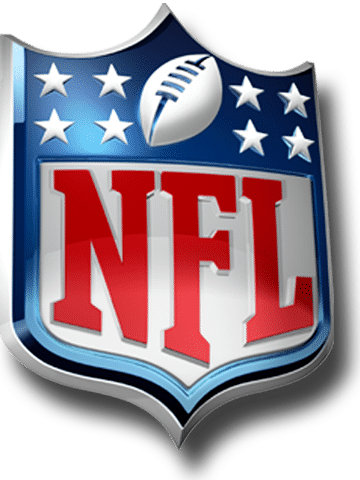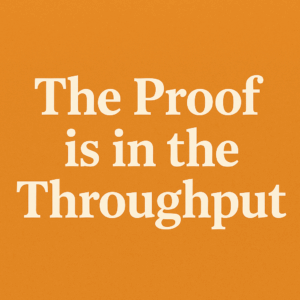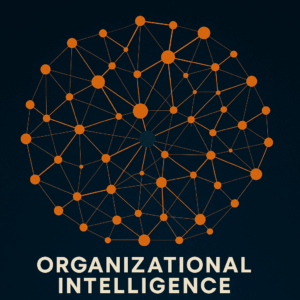Play Smarter to Win the Talent Game
Summary Insight:
Top NFL teams build systems to identify the right talent. Your business should too. Stop seeking the one in a million candidate. Start drafting for system fit.
Key Takeaways:
- Winning teams hire for system fit, not only star power.
- The New Hire Draft Board turns chaos into clarity.
- Build a shared language to spot, develop, and retain talent.
The NFL is the most popular professional sports league in the United States. In fact, it’s bigger than the next three largest professional sports leagues combined. But when it comes to the field of talent management, what makes the NFL such an interesting case study for businesses of all types and sizes is not its popularity but its parity.
Each season, all 32 NFL teams begin with the same basic chance to be competitive. All teams have a roughly equal amount of money to spend and the same numbers of players to a roster, and the worst teams from last season get higher draft picks and an easier schedule this season. If a team gets “harmed” during free agency, the league will assign it compensatory draft picks to help it stay even.
Parity in the NFL has worked. On any given Sunday, one team can beat another. However, a few teams — despite parity — have been able to win consistently over time. In fact, over the past 13 NFL seasons from 1999 to 2012, just 6 teams out of 32 have achieved a 60% or better winning percentage: the Patriots, Colts, Steelers, Packers, Ravens, and Eagles, with only one team achieving a 70% winning percentage: the Patriots.
Clearly, if everything else is held nearly equal, then these winning teams have cultivated an edge in how they go about managing their business and developing their front office and on-field staff. Is there something you can learn from these consistent winners? And if there is something you can take away, can you actually apply it in growing your own business — a business that probably has just a fraction of the money and assessment resources that an NFL team can throw at the hiring problem? And can you teach it to your own team?
These are smart questions to ask. Even if you don’t follow the NFL or understand the rules of the game, anyone can appreciate the dedication it takes to thrive over time in a highly competitive setting. True, the NFL has its problems and its detractors. It’s violent beyond belief. It’s hypocritical when it comes to player safety. Its locker rooms and rosters are filled with some great men and some giant a@*!#$. That said, the NFL absolutely provides some critical insights for how to think about and approach the hiring process for every business, not just a professional sports team.
While you may not have considered the similarities between your business and an NFL team before, there are many. First, you too are faced with intense competition for great talent. Second, you can’t just throw money at the problem. You have finite time, energy, and resources to make great hires and avoid bad ones. Third, when an athlete is drafted and signed to a professional contract, they’re effectively being hired to do a job just as you hire an employee or independent contractor to do a job. So while your “draft picks” don’t get interviewed on ESPN, the fundamentals of getting the right talent at the right price are the same. Fourth, and most important, you’re not just looking to hire individual talent; you’re looking to build a winning team.
How Should You Solve the Hiring Puzzle?

Just as the NFL pours millions of dollars into how it assesses and hires potential draft picks, businesses of all types and sizes do the same when it comes to hiring. In fact, according to a recent IDC report, businesses actually spend over $85B each year trying to make the hiring process more efficient and effective. They invest in recruiting services, comparative profiling, psychometric tests, research, training, and other ways to try to get an edge in hiring and make it a little less painful.
Despite these massive investments, hiring is still a messy, expensive, convoluted process. For instance, in a recent Career Builder Survey of over 6,000 hiring managers from the world’s ten largest economies, more than half report making a bad hire that caused significant harm to revenues, productivity, client relations, or morale costing more than $50,000 per bad hire.
If you’ve been in the business world for more than a year, then you don’t need these stats to tell you how painful it is to make a bad hire and how challenging it is to get the hiring process right. If you can solve the hiring puzzle, then you can transform your business. If you can’t, and you make a string of bad hires, then you’re soon going to be out of business.
So what can you learn from the NFL winningest teams that hasn’t yet been captured by one of these tools, services, or recruiting firms? Why do businesses pour so many resources into it and still come up short? And can the hiring process ever be truly improved or will it always be an expensive crapshoot?
If you were to ask today’s HR experts on how to improve the hiring process, they’ll tell you that answer lies in having more technology and more data. For instance, there’s a fast-growing startup where I live in Santa Barbara, California, that helps companies scan a candidate’s Facebook page so they can know what that person is really like at home and avoid hiring some whacko. It’s all perfectly legal and EEOC compliant.
There’s yet another company nearby that will do a personality profile on your top performers and then compare them to new job applicants. Supposedly, this approach will weed out the riff raff to help find candidates who mirror the thought patterns and behavior of your existing “A Players.” It’s too bad that this company’s clients haven’t yet understood that high performers actually work best in teams when they are surrounded by complementary, not similar styles of colleagues.
Or perhaps you’ll hear that poor hiring is actually a supply side problem that occurs from a lack of adequately trained candidates coming out of colleges, universities, and trade schools. The solution therefore lies in how we prepare young people to enter the workforce and older people to transition their skills. If you believe this, then I know a few politicians who’d love to speak with you. Bring your checkbook.
The fact is that technology and training can play a part in improving the hiring process. But most NFL teams have near-equal technical capabilities and near-equal training regimes. Sure, every few seasons one team might develop an innovative technical or training edge, but that edge is quickly wiped out when other teams copy it. (The NFL is notorious as a copy-cat league. If something seems to be working, teams will quickly adopt it for their own use).
And if you were to ask the common fan why some teams perform consistently better than the rest, they’d tell you it’s because those teams have a great coach and a great quarterback. “Why have the Patriots won 70%? Easy. They have Belichick and Brady. ‘Nough said.”
Is that true? There’s some truth to it. Would the 2013 Broncos be who they are without Peyton Manning? Nope. Special players like Manning are hard to find and if you get one, you can build a dynasty around them while they last.
But it’s just as true that stars are developed, not born. We’re all shaped by the systems we inhabit and the NFL is rife with stars who were once rejects on their former teams but were fortunate enough to sign on with another team where their style, values, and talents were a better match – and that’s how they became stars (see Wes Welker or James Harrison).
It’s also true that great players get hurt (just like when a top performer at your company quits unexpectedly or no longer performs like they used to) and when this happens, the teams that don’t consistently win at a high level tend to implode. Those that do win consistently, however, tend to keep on winning, even without those former stars. New players enter the scene but the victories keep piling up.
Finally, two objections I often hear from executives when I tell them that the NFL can teach them about hiring is this: “That’s not applicable to us,” one struggling startup founder told me recently. “The NFL can try out players before hiring them. I wish we could do that. If we could try out staff members before hiring them, we’d do a better job too.” I’ve also heard, “The NFL has tons of standardized data to work with and a common hiring pool to compare players through the draft. If we had that level of standardized data, we’d be world-class at hiring too.”
It’s irksome to me that I hear these objections because executives like these just aren’t getting it. Yes, the NFL can try players out and then decide to keep them or cut them. So what? Your business can do the same. In fact, you should always try to structure your new hire arrangements so that you can date before getting married. It’s called a trial period and it’s easy to do and perfectly appropriate.
And yes, the NFL has lots of standardized data to work with. Team management knows the height, weight, 40-yard dash time, Wonderlic score (an “intelligence” test), and playing history of every prospective and future player.
While most of corporate America and Silicon Valley startups are driving hard to get more and more standardized and relevant information through big data, social gaming, and assessments on potential recruits, again, so what? The consistently winning teams use the same data set and have the same opportunities in the draft (or to recruit outside the draft using free agency) as every other team. Yet they consistently outperform their peers. How?
What the Best NFL Teams Do Differently

Clearly, there’s something beyond technology, data, training, individual talent, and luck that the winningest NFL teams do differently than the rest over time. So what is it?
The answer is both simple and profound: Consistently great teams don’t scout and hire for talent. They scout and hire for talent that is a supreme fit for their system. They always think about building a team with a strong collective identity at a fair price instead of just collecting individual talent at any price.
In addition, great teams tend to develop through the draft rather than relying heavily on expensive free agents. They also have a system for recognizing when to unload an existing player to another team and they manage their payroll (their biggest expense) in such a way so that the organization is healthy in the short and long run.
You too need to hire and develop top-notch managers and players. You too are under intense pressure and competition. And unlike the Yankees or Manchester United, you can’t just throw money at the problem. You’ve got to play “moneyball” instead and find the right mix of skills for your system and at a good value to market rates. You need to build a team, not a collection of mercenaries.
Put another way, the hiring process can be improved in your business by modeling what the NFL’s best teams do – but this doesn’t come from new technology, more training, or getting lucky. It starts with rethinking how you think about the hiring process itself. Unless you and your team have the right paradigm to think about hiring in the first place, then no matter what tools, resources, and processes you deploy, your hiring process is still going to be flawed. Until you think differently, you can’t act differently.
Belichick’s Epiphany

Today, you may know Bill Belichick as the head coach and de facto GM of the New England Patriots and one of the most successful coaches of all time. But 25 years ago, he got his first head coaching start with the lowly Cleveland Browns.
According to the book War Room: The Legacy of Bill Belichick and the Art of Building the Perfect Team, when Belichick took the helm at Cleveland, he was already crystal clear on the type of team he wanted to build — a big, strong, fast team that was capable of playing in any weather, in loud and hostile Rust Belt stadiums, and was smart enough to adjust their schemes each week to take away the biggest strengths of their opponents.
But during his first days on the job he quickly noticed that the Browns’ pro and college scouts, coaches, and administrative staff were not thinking about the hiring process in a smart and unified way. Because they weren’t thinking about it in the right way, they weren’t going about it in the right way, and they certainly wouldn’t be able to create a sustained competitive edge until they changed their thinking:
“[The Browns staff] were not speaking the same language when it came to personnel. There was one grading scale for evaluating the pros and an entirely different one for analyzing collegians. Even worse, in his opinion, there was no organizational identity. After all the scouting, who were the Browns trying to be?
It seemed to him that there wasn’t a good systematic answer to the question, so that became one of his missions: Build one player-evaluation system, for pro and college players alike, that always provided an instant snapshot of who a player was and whether he was capable of helping the Cleveland Browns. When the system was perfected, the coach imagined, everyone in the organization would be able to glance at a couple of numbers and letters on a scouting report and know exactly what type of player was being discussed.”
Belichick was never able to complete such a system for the Browns. A few years after taking the job in Cleveland, the team was moved to Baltimore and Belichick was fired. But the vision was set and years later, when Belichick became the head coach of the New England Patriots, he was able to put such a talent evaluation system in place and, with a few notable exceptions (no Aaron Hernandez jokes here, please), the results have been outstanding.
What Belichick recognized when he started with the Cleveland Browns is that hiring and development of both front office and on-field staff was critical to the organization’s success, but the organization lacked the framework to transform it into a competitive edge to wield against the competition.
It took Belichick years to refine his talent evaluation system. Once he got it going and cascaded it throughout the Patriot scouting teams and front office, however, it transformed a haphazard process into one that is much more accurate, scalable, and powerful.
I’m not saying the Patriots and other top performing teams have been perfect in their drafting and team development (they haven’t) but that the way they think about hiring and the approach they use gives them a slight edge over the other teams. And in a highly competitive setting, a slight edge makes a significant difference.
To drive this point home, I’d like you to reflect for a moment about how exactly you think about the hiring process in your business today. Are you searching for a particular personality? A salary range? Past experience? Education or credentials? A personal referral? Commitment to a vision? Job skills? Upside potential? Cultural fit? Avoiding a future liability? All of the above? And if you are clear on the above, how do you go about determining it? What tradeoffs are you willing to accept and why? Finally, how do you — and your team — actually know it when you see it in a way that everyone can agree on?
Chances are that you don’t have a unified answer to these questions nor a systematic way to find answers. And if you should happen to have an answer personally, does the rest of your company’s hiring team know the answer too? Probably not. In order to create a unified and systematic approach to hiring, one that guides you and your team to find the right candidates and avoid the wrong ones, you need a framework to follow.
The New Hire Draft Board: The Ultimate Talent Management Framework
Every season the NFL has a draft for new players. There’s a lot of organizational focus and media attention on the draft. It gets NFL fans in a tizzy of excitement too. “Who will our team draft this year?” “Will they botch it up again?” “Is there hope for the Browns finally?”
Before and during the draft, each team creates its own version of a draft board. The draft board helps team management to think about where they believe the relative value of a prospective player is compared to the “market demand” and the team’s needs.
If you’ve ever heard an NFL GM tell the media, “we worked our draft board perfectly this year,” what he’s really saying is that he believes the team got the players it wanted for the price they wanted to pay.
Even though your organization doesn’t hire employees all at once during a certain time of year like the draft or recruit employees in a hierarchy of rounds, but rather by pressing organizational need, you still need your own version of a “draft board” that allows you to think clearly and accurately about who to hire and why (and who not to hire and why) and where the value of a particular candidate lies.
If you had such a system, then you could place any prospective new hire on the draft board and see if they’re a fit or not, what the trade offs are for each candidate, and how candidates compare to existing staff and even glean insights into how to best recruit, manage, and develop them. In a word, the draft board brings clarity.
The right draft board will not only apply to prospective new hires but also to existing staff. That is, if you were to place an existing staff member on the draft board, it would tell you if they need a raise, if they’re suitable for a new position or are ready to be promoted into a leadership position, or if it’s time to let them go and find someone new.
Below is just such a draft board. It’s based on the team leadership framework created by legendary San Francisco 49ers football coach and GM Bill Walsh who was the architect of the 49ers football dynasty in the 1980s. There’s a richness of detail here, but for now just scan it quickly to get a sense for what a blank new hire draft board looks like:
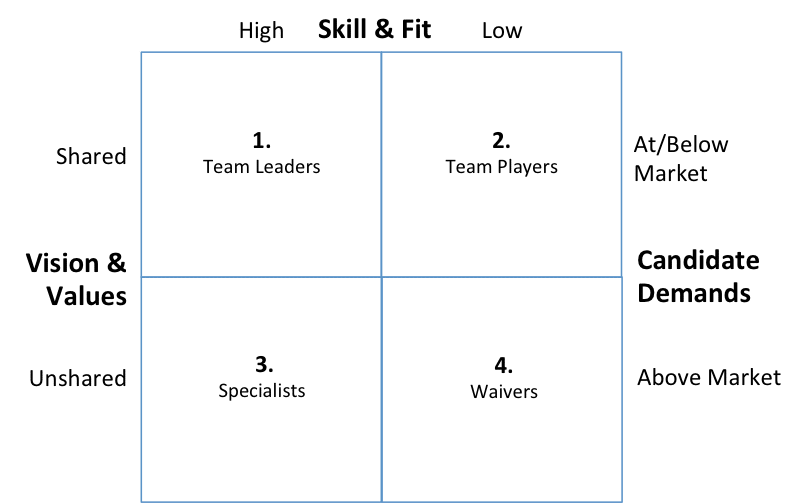
Like most great things in life, this draft board is both simple and powerful. It groups all of an organization’s current staff and/or potential job candidates into one of four quadrants:
- The Team Leaders in quadrant 1 demonstrate high skills and fit for this position or role, they have shared vision and values, and they demand fair compensation (defined as at or below market rates for your industry and corporate lifecycle stage) for this position. That is, they could get more money elsewhere but they choose to take less because they intrinsically value being part of the team and opportunity in a role that is well suited to their strengths and interests.
- Team Leaders define “the way” of your organization much like Peyton Manning or Tom Brady are team leaders who define the way of their respective teams. “Hey rookie, see how Peyton Manning studies film every morning at 6am? That’s the kind of player we want around here. Prepare like he does and you’ll do just fine.”
Think of your Team Leaders as stars, starters, or captains. You want to reward and retain them for as long as possible. Give them ownership opportunities, career paths, autonomy, and support them as role models for the rest of the company.
- The Team Players in quadrant 2 don’t have the same technical skills, fit, or experience as a Team Leader but they share the same desired vision and values and don’t cost an arm and a leg relative to market price.
-
Team Players are valuable to your success and you definitely want them around. It’s very hard to find people who share the same vision and values and embody “the way” of your organization. If they have the raw talent, it’s much easier to develop their technical capabilities over time to become Team Leaders or if not, to remain as valuable role players. It may also be that, as they develop their capabilities and acumen, a role in the organization opens up that is a very strong fit for their style.
Think of your Team Players as your role players or bench. You need to coach them to develop their technical proficiency and groom them into the right role while still celebrating them as key contributors to the team’s success.
- The Specialists in quadrant 3 have high technical skills and are a strong style fit for the job, but they don’t share the same vision and values and/or may be very expensive compared to market rates.
-
Specialists are viewed as highly capable experts that don’t fit into the desired organizational culture. While specialists can get the job done, great organizations rely on them sparingly and never place them in core leadership positions because the specialist doesn’t share the desired vision and values. Much like having a primadonna wide receiver like “Ocho Cinco” in an NFL locker room can shift the focus from the collective “we” of the team to the “me” of the individual ego, a specialist in a leadership position who doesn’t embody the desired vision and values can quickly turn a once winning organizational culture into one that is toxic and self-defeating.
Think of Specialists like mercenaries or free agents who get paid well to perform a specific function well. If you do choose to use them to fill in some talent gaps, keep them on the periphery of the organizational core and pay them cash on the barrelhead for a job well done.
The biggest mistake you can make when hiring a specialist is to delude yourself into thinking that you can mold them into a Team Leader with the proper incentives and motivation. Don’t do it! They are who they are, and no amount of incentives is going to change that fact unless they themselves want to change.
Even with a strong individual commitment to change, personal character development can take a long time and can easily be tripped up. Therefore, if you do hire a Specialist, avoid putting them in a leadership position but allow them to express their high level of skills and acumen outside of the organizational leadership core.
- The Waivers in quadrant 4 do not have the skills and fit and do not buy into the desired vision and values. Or, they simply demand way too much compensation beyond market rates for a company of your size and industry.
-
Waivers are who you’re trying to avoid hiring in the first place. The easiest time to make a waiver is before they even get hired! So if in the interviewing process you notice the signals of a quadrant 4, it’s straightforward: DO NOT HIRE.
The next hardest waiver to make is an employee who sneaked through the hiring process and turned out to be a poor fit that now sucks everyone’s time and energy. They don’t perform at a high level and they don’t embody the desired cultural traits. So why do you have them around? Now that you’ve recognized the mistake, fix it. Fire ‘em or trade ‘em to the competition. Fast.
By far, the hardest waivers to make are those former Team Leaders and Team Players who just no longer have the high level of technical skills or fit within the evolving organization, or who are just demanding too much compensation relative to market rates for a company of your size and industry.
While it’s hard to say goodbye to these once valued team members, it’s even harder to be burdened with excessive overhead and a diminishing skill set. (Just ask the Raiders who have been mired in trying to work themselves out of expensive and underperforming contracts for the past five years).
That’s the four main quadrants of the draft board: #1 Team Leaders, #2 Team Players, #3 Specialists, and #4 Waivers. You should notice immediately that this framework provides a strong foundation for how to think about who’s on your team now and who you want on your team in the future. It tells you that:
- You need a strong core of #1 Team Leaders who are extremely talented at what they do, are a great fit for your system, share the desired vision and values, and will work at a fair price relative to market rates.
- You need a deep bench of #2 Team Players who aren’t yet as talented as the starters (or there’s not the same level of job fit) but buy into the desired organizational culture at also do so at fair market price.
- For the most part, you want to avoid using #3 Specialists who, if placed in a leadership position, can quickly turn the organizational culture toxic or tip the payroll balance by demanding exorbitant fees to be part of the core team.
- You must avoid hiring and retaining #4 Waivers who don’t have the skills, aren’t a fit, don’t buy into the vision and values, or make it too expensive in time, energy, and/or money to keep them around.
As you can see, the draft board framework provides a very strong foundation for how to think about the type of players you want on your team. It’s pretty straightforward to master the basic concept and it’s simple for everyone involved in the hiring process to understand.
The PSIU Code: A Common Language for Hiring Success
The draft board framework also sets the stage to create a powerful common language within your company. A common language, or code, promotes rapid communication and instant understanding. Having such a code is incredibly important to not only the hiring process but also to overall communication and organizational performance.
The winningest teams in the NFL understand this. Each one uses their own proprietary written code or shorthand to define players’ skills and fit within their system. The Patriots, for instance, use an intricate upper- and lower-case letter and numbered grading system that compares a potential draft pick or free agent against existing players on the Patriot’s roster.
Patriot scouts are required to rank a player using this internal code to describe not only physical characteristics, but also how those players play the game and fit within the Patriots’ system. (Is this player aggressive? Smart? Instinctual? Observant? Tough? Passionate? Studious? etc.).
Using a code to identify and communicate the kind of player the team needs for any particular position is brilliant. Because once you know the language, this allows a near-instantaneous understanding of an existing player or potential draft picks. It also forces the entire organization to get on the same page when it comes to knowing what an ideal player represents – e.g., What does a starting Patriot linebacker look like and how should they go about their job? The code tells it.
Your business needs a similar code – and the draft board framework provides it. The code needs to be able to answer this question: “What are the desired characteristics for this role and is there a match with this employee or job candidate?” The code must be simple, fast to use, and easily understandable by everyone involved in the hiring process.
Here is an example of the start of an active draft board with a simple code. This draft board is for a new Head of Operations role for an expansion-stage healthcare technology company. It includes the new shorthand code that you will soon master.
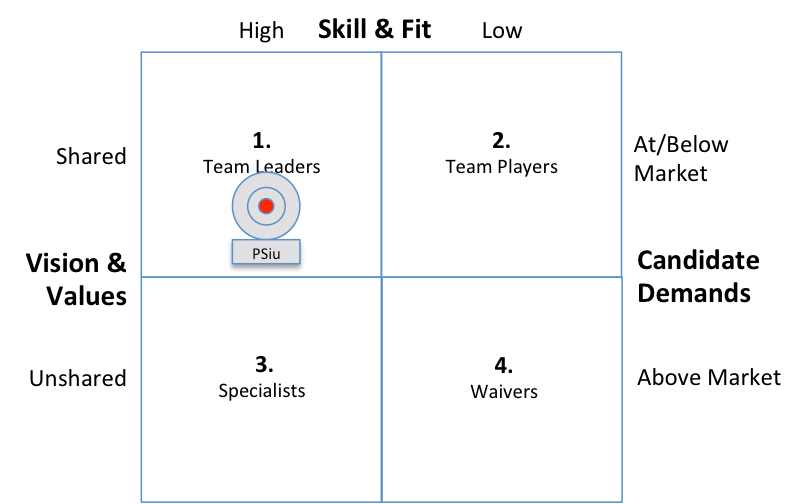
Learning a new language takes a bit of practice but already you should have an initial grasp of the type of candidate this company wants just by glancing at the draft board target. What can we tell?
The company is seeking a #1 Team Leader who demonstrates high job skills and high style fit for the role, who shares the desired vision and values, and who demands fair compensation compared to market. In addition, we can tell that the right candidate is a Producer/Stabilizer style (PSiu) in their approach — meaning that he or she will thrive when working to accomplish the daily/weekly work and to bring order or efficiency out of chaos.
PSIU stands for the Producing, Stabilizing, Innovating, and Unifying forces (think “PS. I love U” to remember them) and is a form of management shorthand that tells you what kind of style, strengths, and approach you require from any given position. As I explain in my book Organizational Physics: The Science of Growing a Business, these four forces show up in individual management styles as a result of how we learn to drive and respond to change and to focus on the parts or the whole of the system we’re in.
“OK,” I can almost hear you saying. Seems simple enough. But how do I determine where each candidate is on the draft board?” Well, that’s the purpose of your recruitment and interviewing process! That is, a good recruitment and interview process will quickly and cost-effectively identify where a candidate is on the draft board. A poor recruitment and interview process won’t provide that level of insight or it will take too long and cost too much to find the answers.
Before you start diving into how you’ll build a new recruiting and interviewing process to support the draft board framework, I’d like you to pause and reflect for a moment. Remember earlier when I asked you how exactly you think about the hiring process in your business today?
”Are you searching for a particular personality? A salary range? Past experience? Education or credentials? A personal referral? Commitment to a vision? Job skills? Upside potential? Cultural fit? Avoiding a future liability? All of the above? And if you are clear on the above, how do you go about determining it? What tradeoffs are you willing to accept and why? Finally, how do you — and your team — actually know it when you see it in a way that everyone can agree on?”
Well, guess what? Now that you are starting to get an initial feel for the draft board framework, can you see that you’re already well on your way to answering those questions now and forever? No matter how you slice it, from now on when you think about the hiring process, you’ll know what to think about:
Are you in search of a “#1 Team Leader” and will you only accept a “#1 Team Leader” because this is a critical leadership position and you must have captain who walks the talk and demonstrates a high level of skill and fit?
Or will you accept a “#3 Specialist” for this position because it is outside the company core and you just need a high level of technical skill and role fit to get the job done?
Perhaps you are in the market for a “#2 Team Player” but you’ll expand the scope to a “#1 Team Leader” if you stumble across the right candidate? Or is this purely a “#2 Team Player” hire because that’s all that’s really required for this role?
And what is the style of candidate who will naturally thrive in this role based on the job requirements and the complementary skills and gaps in the team? Do you need a high Producer/Innovator who thrives at winning and coming up with creative solutions to complex problems? Or would it be a Stabilizer/Unifier style who brings order out of chaos while keeping the team and clients on the same page? Or a different style altogether?
There are still a lot of details to answer and those answers will come soon enough. But what’s really important (and valuable) is having a framework to ask the right questions in the first place! And that’s exactly what the draft board framework gives you: A new way to think about hiring, along with the right questions to ask.
Now that you have a snapshot of the draft board framework, the next step is to understand how to put it into action. Once you know the how, then you can tackle the when to hire and who to hire. But right now, don’t rush past small victories. Take a moment to savor them. You now have a seriously powerful framework for how to think about the hiring process.
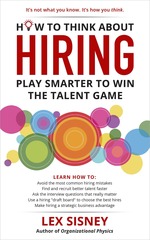 This post is an excerpt from How to Think About Hiring: Play Smarter to Win the Talent Game.
This post is an excerpt from How to Think About Hiring: Play Smarter to Win the Talent Game.
